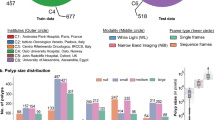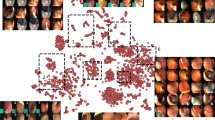Abstract
While several previous studies have devised methods for segmentation of polyps, most of these methods are not rigorously assessed on multi-center datasets. Variability due to appearance of polyps from one center to another, difference in endoscopic instrument grades, and acquisition quality result in methods with good performance on in-distribution test data, and poor performance on out-of-distribution or underrepresented samples. Unfair models have serious implications and pose a critical challenge to clinical applications. We adapt an implicit bias mitigation method which leverages Bayesian epistemic uncertainties during training to encourage the model to focus on underrepresented sample regions. We demonstrate the potential of this approach to improve generalisability without sacrificing state-of-the-art performance on a challenging multi-center polyp segmentation dataset (PolypGen) with different centers and image modalities.
Access this chapter
Tax calculation will be finalised at checkout
Purchases are for personal use only
Similar content being viewed by others
Notes
- 1.
C1-5-SEQ and C6-SEQ data are referred to as DATA3 and DATA4, respectively, in [2].
- 2.
References
Abbasi-Sureshjani, S., Raumanns, R., Michels, B.E.J., Schouten, G., Cheplygina, V.: Risk of training diagnostic algorithms on data with demographic bias. In: Cardoso, J., et al. (eds.) IMIMIC/MIL3ID/LABELS -2020. LNCS, vol. 12446, pp. 183–192. Springer, Cham (2020). https://doi.org/10.1007/978-3-030-61166-8_20
Ali, S., Ghatwary, N., Jha, D., Isik-Polat, E., Polat, G., Yang, o.: Assessing generalisability of deep learning-based polyp detection and segmentation methods through a computer vision challenge. ar**v preprint: ar**v:2202.12031 (2022)
Ali, S., et al.: A multi-centre polyp detection and segmentation dataset for generalisability assessment. Sci. Data 10(1), 75 (2023)
Amini, A., Soleimany, A.P., Schwarting, W., Bhatia, S.N., Rus, D.: Uncovering and mitigating algorithmic bias through learned latent structure. In: Proceedings of the 2019 AAAI/ACM Conference on AI, Ethics, and Society, pp. 289–295 (2019)
Branchaud-Charron, F., Atighehchian, P., Rodríguez, P., Abuhamad, G., Lacoste, A.: Can active learning preemptively mitigate fairness issues? ar**v preprint: ar**v:2104.06879 (2021)
Burlina, P., Joshi, N., Paul, W., Pacheco, K.D., Bressler, N.M.: Addressing artificial intelligence bias in retinal diagnostics. Transl. Vis. Sci. Technol. 10(2), 13–13 (2021)
Cao, S., Zhang, Z.: Deep hybrid models for out-of-distribution detection. In: Proceedings of the IEEE/CVF Conference on Computer Vision and Pattern Recognition, pp. 4733–4743 (2022)
Chen, L.C., Papandreou, G., Kokkinos, I., Murphy, K., Yuille, A.L.: DeepLab: semantic image segmentation with deep convolutional nets, Atrous convolution, and fully connected CRFs. IEEE Trans. Pattern Anal. Mach. Intell. 40(4), 834–848 (2018)
Chen, L.-C., Zhu, Y., Papandreou, G., Schroff, F., Adam, H.: Encoder-decoder with Atrous separable convolution for semantic image segmentation. In: Ferrari, V., Hebert, M., Sminchisescu, C., Weiss, Y. (eds.) ECCV 2018. LNCS, vol. 11211, pp. 833–851. Springer, Cham (2018). https://doi.org/10.1007/978-3-030-01234-2_49
Du, M., Mukherjee, S., Wang, G., Tang, R., Awadallah, A., Hu, X.: Fairness via representation neutralization. In: Advances in Neural Information Processing Systems, vol. 34, pp. 12091–12103 (2021)
Gal, Y., Ghahramani, Z.: Dropout as a Bayesian approximation: representing model uncertainty in deep learning. In: International Conference on Machine Learning, pp. 1050–1059. PMLR (2016)
Gonzalez, C., Gotkowski, K., Bucher, A., Fischbach, R., Kaltenborn, I., Mukhopadhyay, A.: Detecting when pre-trained nnU-Net models fail silently for Covid-19 lung lesion segmentation. In: de Bruijne, M., et al. (eds.) MICCAI 2021. LNCS, vol. 12907, pp. 304–314. Springer, Cham (2021). https://doi.org/10.1007/978-3-030-87234-2_29
Hendrycks, D., Mazeika, M., Kadavath, S., Song, D.: Using self-supervised learning can improve model robustness and uncertainty. In: Advances in Neural Information Processing Systems, vol. 32 (2019)
Jungo, A., Balsiger, F., Reyes, M.: Analyzing the quality and challenges of uncertainty estimations for brain tumor segmentation. Front. Neurosci. 14, 282 (2020)
Khan, S., Hayat, M., Zamir, S.W., Shen, J., Shao, L.: Striking the right balance with uncertainty. In: Proceedings of the IEEE/CVF Conference on Computer Vision and Pattern Recognition, pp. 103–112 (2019)
Kim, N., Hwang, S., Ahn, S., Park, J., Kwak, S.: Learning debiased classifier with biased committee. ar**v preprint: ar**v:2206.10843 (2022)
Li, X., Cui, Z., Wu, Y., Gu, L., Harada, T.: Estimating and improving fairness with adversarial learning. ar**v preprint: ar**v:2103.04243 (2021)
Mahmud, T., Paul, B., Fattah, S.A.: PolypSegNet: a modified encoder-decoder architecture for automated polyp segmentation from colonoscopy images. Comput. Biol. Med. 128, 104119 (2021)
Mehrabi, N., Morstatter, F., Saxena, N., Lerman, K., Galstyan, A.: A survey on bias and fairness in machine learning. ACM Comput. Surv. (CSUR) 54(6), 1–35 (2021)
Mehrtash, A., Wells, W.M., Tempany, C.M., Abolmaesumi, P., Kapur, T.: Confidence calibration and predictive uncertainty estimation for deep medical image segmentation. IEEE Trans. Med. Imaging 39(12), 3868–3878 (2020)
Nam, J., Cha, H., Ahn, S., Lee, J., Shin, J.: Learning from failure: De-biasing classifier from biased classifier. In: Advances in Neural Information Processing Systems, vol. 33, pp. 20673–20684 (2020)
Pezeshki, M., Kaba, O., Bengio, Y., Courville, A.C., Precup, D., Lajoie, G.: Gradient starvation: a learning proclivity in neural networks. In: Advances in Neural Information Processing Systems, vol. 34, pp. 1256–1272 (2021)
Puyol-Antón, E., et al.: Fairness in cardiac MR image analysis: an investigation of bias due to data imbalance in deep learning based segmentation. In: de Bruijne, M., et al. (eds.) MICCAI 2021. LNCS, vol. 12903, pp. 413–423. Springer, Cham (2021). https://doi.org/10.1007/978-3-030-87199-4_39
Ronneberger, O., Fischer, P., Brox, T.: U-Net: convolutional networks for biomedical image segmentation. In: Navab, N., Hornegger, J., Wells, W.M., Frangi, A.F. (eds.) MICCAI 2015. LNCS, vol. 9351, pp. 234–241. Springer, Cham (2015). https://doi.org/10.1007/978-3-319-24574-4_28
Seyyed-Kalantari, L., Liu, G., McDermott, M., Chen, I.Y., Ghassemi, M.: CheXclusion: fairness gaps in deep chest X-ray classifiers. In: BIOCOMPUTING 2021: Proceedings of the Pacific Symposium, pp. 232–243. World Scientific (2020)
Shen, Z., et al.: Towards out-of-distribution generalization: a survey. ar**v preprint: ar**v:2108.13624 (2021)
Silva, J., Histace, A., Romain, O., Dray, X., Granado, B.: Toward embedded detection of polyps in WCE images for early diagnosis of colorectal cancer. Int. J. Comput. Assist. Radiol. Surg. 9, 283–293 (2014)
Simonyan, K., Zisserman, A.: Very deep convolutional networks for large-scale image recognition. In: 3rd International Conference on Learning Representations, ICLR 2015, San Diego, CA, USA, 7–9 May 2015, Conference Track Proceedings (2015)
Srivastava, A., et al.: MSRF-Net: a multi-scale residual fusion network for biomedical image segmentation. IEEE J. Biomed. Health Inform. 26(5), 2252–2263 (2022)
Stone, R.S., Ravikumar, N., Bulpitt, A.J., Hogg, D.C.: Epistemic uncertainty-weighted loss for visual bias mitigation. In: Proceedings of the IEEE/CVF Conference on Computer Vision and Pattern Recognition, pp. 2898–2905 (2022)
Wang, M., Deng, W.: Mitigating bias in face recognition using skewness-aware reinforcement learning. In: Proceedings of the IEEE/CVF Conference on Computer Vision and Pattern Recognition, pp. 9322–9331 (2020)
Welling, M., Teh, Y.W.: Bayesian learning via stochastic gradient Langevin dynamics. In: Proceedings of the 28th International Conference on Machine Learning (ICML-11), pp. 681–688. Citeseer (2011)
Xu, X., et al.: Consistent instance false positive improves fairness in face recognition. In: Proceedings of the IEEE/CVF Conference on Computer Vision and Pattern Recognition, pp. 578–586 (2021)
Yeung, M., Sala, E., Schönlieb, C.B., Rundo, L.: Focus U-Net: a novel dual attention-gated CNN for polyp segmentation during colonoscopy. Comput. Biol. Med. 137, 104815 (2021)
Zhang, R., Li, C., Zhang, J., Chen, C., Wilson, A.G.: Cyclical stochastic gradient MCMC for Bayesian deep learning. In: International Conference on Learning Representations (2020)
Acknowledgements
R. S. Stone is supported by Ezra Rabin scholarship.
Author information
Authors and Affiliations
Corresponding authors
Editor information
Editors and Affiliations
Rights and permissions
Copyright information
© 2023 The Author(s), under exclusive license to Springer Nature Switzerland AG
About this paper
Cite this paper
Stone, R.S., Chavarrias-Solano, P.E., Bulpitt, A.J., Hogg, D.C., Ali, S. (2023). Bayesian Uncertainty-Weighted Loss for Improved Generalisability on Polyp Segmentation Task. In: Wesarg, S., et al. Clinical Image-Based Procedures, Fairness of AI in Medical Imaging, and Ethical and Philosophical Issues in Medical Imaging. CLIP EPIMI FAIMI 2023 2023 2023. Lecture Notes in Computer Science, vol 14242. Springer, Cham. https://doi.org/10.1007/978-3-031-45249-9_15
Download citation
DOI: https://doi.org/10.1007/978-3-031-45249-9_15
Published:
Publisher Name: Springer, Cham
Print ISBN: 978-3-031-45248-2
Online ISBN: 978-3-031-45249-9
eBook Packages: Computer ScienceComputer Science (R0)





